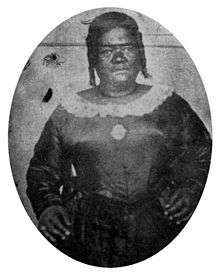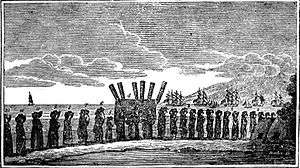Kekauʻōnohi
Keahikuni Kekauʻōnohi (c. 1805–1851) was a Hawaiian high chiefess who was a member of the House of Kamehameha. She was granddaughter to King Kamehameha I and one of the wives of Kamehameha II. Her Christian name is disputed; it is given as Mikahela in the 1848 Mahele Book and as Miriam in later sources.[1][2][3]
| Kekauʻōnohi | |||||
|---|---|---|---|---|---|
 | |||||
| Born | c. 1805 Lahaina, Maui | ||||
| Died | June 2, 1851 Honolulu, Oʻahu | ||||
| Burial | June 30, 1851[1] | ||||
| Spouse | Kamehameha II (as Queen) Kahalaiʻa Luanuʻu Kealiʻiahonui Levi Haʻalelea | ||||
| Issue | William Pitt Kīnaʻu II Abigail Maheha (hānai) Mary Ann Kiliwehi (hānai) Anna Kaiʻulani (hānai) | ||||
| |||||
| House | House of Kamehameha | ||||
| Father | Kahōʻanokū Kīnaʻu | ||||
| Mother | Kahakuhaʻakoi Wahinepio | ||||

Biography
She was born circa 1805 at Lahaina, Maui. Her father was Kahōʻanokū Kīnaʻu. Her mother was Kahakuhaʻakoi Wahinepio, sister of Boki and Kalanimoku and granddaughter of Aliʻi Nui, Kekaulike of Maui. Her father was a son of Kamehameha I and his wife Peleuli, daughter of Kamanawa, one of the royal twins.[4]
She married her uncle Kamehameha II. She was one of his five wives. Others were Kamāmalu, Pauahi, Kīnaʻu, and Kekāuluohi. She was the youngest, but Kamāmalu was Liholiho's favorite.[5][6] She was at the famous meal when the kapu system was overturned in 1819, known as the ʻAi Noa. After Liholiho's death in London, she went to Kauaʻi to live with her half-brother Kahalaiʻa Luanuʻu, who served as governor of Kauaʻi from 1824 to 1825.[7][8]
Kekauʻōnohi served as a governor of the island of Kauaʻi some time around 1840–1845[9] and was a stanch Protestant.[10] Kamehameha III created the House of Nobles in the Hawaiian Constitution of 1840.[11] She was among the first members along with the King, Hoapiliwahine, Pākī, Kōnia, Keohokalole, Kuakini, Kahekili, Leleiohoku I, Kekuanaoa, Kealiʻiahonui, Kanaʻina, Keoni ʻĪʻī, Keoni Ana, and Haʻalilio.[12]
After the death of Kuhina Nui, Kaʻahumanu in 1832, she remarried Kealiʻiahonui, former aliʻi of Kauaʻi and the son of Al'iʻI Nui, Kaumualiʻi of Kauaʻi. They had no children. After his death in 1849 she remarried Levi Haʻalelea, a relative of Queen Kalama (wife of Kamehameha III) and had a son named William Pitt Kīnaʻu, who died young.[13][14] After the Great Mahele in 1848, Kekauʻōnohi was given the second-largest land allotments, seventy-seven ʻāina (land parcels), making her the largest landholder after the King. She inherited most of the land of her uncle William Pitt Kalanimoku along with land given to her by her other relatives: Kamehameha III, Kaukuna Kahekili, Kaiko, Koahou, her aunt Maheha, her mother Kahakuhaʻakoi Wahinepio and Hao.[15] She died in Honolulu June 2, 1851 age 46. Stephen Reynolds in his Journal noted at her death that she was "the last of the old stock of chiefs – one of the best of them – good-natured, benevolent, liberal and generous."[16] She left her land to her husband Haʻalelea.[17] She was foster mother of her nieces Abigail Maheha, Mary Ann Kiliwehi and Anna Kaiʻulani.[18] [19]
When the Admiral Henry Byam Martin, aboard HMS Grampus, visited the islands in 1846, he described the Princess Kikuanoki:
The arrival of Kikuanoki — granddaughter of Kamehameha 1st and 1st cousin of the present King — was a treat. She sailed into the room with all the pomp and majesty of Q. Elizabeth. Her dress — evidently got up for the occasion — was a very transparent muslin shirt — through which those parts of her person which in most countries are covered were very visible. A green crape shawl — and a band of red & yellow (the royal colours) round her head completed her costume.[20]
References
- Forbes 2001, p. 11.
- Kameʻeleihiwa 1992, pp. 290-291.
- Hawaii Supreme Court & Davis 1866, p. 543.
- Liliuokalani 1898, pp. 401–403.
- Stewart 1839, p. 261.
- Bingham 1855, p. 185.
- Freycinet 1978, pp. 107–108.
- Kamakau 1992, p. 266.
- "Governor of Kauai" (PDF). state archives digital collections. state of Hawaii. Archived from the original (PDF) on 2011-07-21. Retrieved 2009-11-24.
- Joesting 1988, p. 146.
- "Kekauonohi, M office record". state archives digital collections. state of Hawaii. Archived from the original on 2011-10-07. Retrieved 2009-11-24.
- Hill 1856, p. 413.
- Pratt 2009, p. 40.
- Liliuokalani 1898, p. 405.
- Kameʻeleihiwa 1992, pp. 243, 307.
- Reynolds 1989, pp. 94, 110, 211, 224, 269.
- Kameʻeleihiwa 1992, p. 307.
- Liliuokalani 1898, pp. 8, 401.
- Honolulu Almanac and Directory 1884, p. 76.
- Martin 1981, pp. 25–26.
Bibliography
| Wikimedia Commons has media related to Kekauʻōnohi. |
- Bingham, Hiram (1855) [1848]. A Residence of Twenty-one Years in the Sandwich Islands (Third ed.). Canandaigua, NY: H. D. Goodwin.CS1 maint: ref=harv (link)
- Biographical Sketch of His Majesty King Kalakaua. Honolulu Almanac and Directory. Honolulu: P. C. Advertiser Steam Printing Office. 1884. pp. 72–74. OCLC 12787107.
- Forbes, David W., ed. (2001). Hawaiian National Bibliography, 1780-1900. 3. Honolulu: University of Hawaii Press. pp. 11, 390. ISBN 0-8248-2503-9.CS1 maint: ref=harv (link)
- Freycinet, Louis de (1978). Kelly, Marion (ed.). Hawaií in 1819: A Narrative Account. Honolulu: Department of Anthropology, Bernice Pauahi Bishop Museum.CS1 maint: ref=harv (link)
- Hawaii Supreme Court; Davis, Robert G. (1866). "L Keelikolani v. James Robinson". Reports of a Portion of the Decisions Rendered by the Supreme Court of the Hawaiian Islands in Law, Equity, Admiralty, and Probate. 2. pp. 514–552.CS1 maint: ref=harv (link)
- Hill, Samuel S. (1856). Travels in the Sandwich and Society Islands. London: Chapman & Hall. pp. 207–208.CS1 maint: ref=harv (link)
- Joesting, Edward (1988). Kauai: The Separate Kingdom. Honolulu: University of Hawaii Press. ISBN 978-0-8248-1162-4.CS1 maint: ref=harv (link)
- Kamakau, Samuel (1992) [1961]. Ruling Chiefs of Hawaii (Revised ed.). Honolulu: Kamehameha Schools Press. ISBN 0-87336-014-1.CS1 maint: ref=harv (link)
- Kameʻeleihiwa, Lilikalā (1992). Native Land and Foreign Desires. Honolulu: Bishop Museum Press. ISBN 0-930897-59-5.CS1 maint: ref=harv (link)
- Liliuokalani (1898). Hawaii's Story by Hawaii's Queen, Liliuokalani. Boston: Lee and Shepard. ISBN 978-0-548-22265-2.CS1 maint: ref=harv (link)
- Lydecker, Robert Colfax, ed. (1918). Roster Legislatures of Hawaii, 1841-1918. Honolulu: Hawaiian Gazette Company.CS1 maint: ref=harv (link)
- Martin, Henry Byam (1981). The Polynesian Journal of Captain Henry Byam Martin, R. N. (PDF). Canberra: Australian National University Press. hdl:1885/114833. ISBN 978-0-7081-1609-8. OCLC 8329030.CS1 maint: ref=harv (link)
- Pratt, Elizabeth Kekaaniauokalani Kalaninuiohilaukapu (2009) [1920]. Daniel Logan (ed.). History of Keoua Kalanikupuapa-i-nui: Father of Hawaii Kings, and His Descendants. Honolulu: republished by Kessinger Publishing. ISBN 978-1-104-76661-0.CS1 maint: ref=harv (link)
- Reynolds, Stephen (1989). Joerger, Pauline King (ed.). Journal of Stephen Reynolds: 1823–1829. Honolulu: Ku Paʻa Incorporated. ISBN 978-0-914916-80-2. OCLC 20465590.CS1 maint: ref=harv (link)
- Stewart, Charles Samuel (1839). Ellis, William (ed.). A Residence in the Sandwich Islands. Boston: Weeks, Jordan & Company.CS1 maint: ref=harv (link)
| Preceded by Keaweamahi |
Royal Governor of Kauaʻi 1842–1845 |
Succeeded by Paul Kanoa |